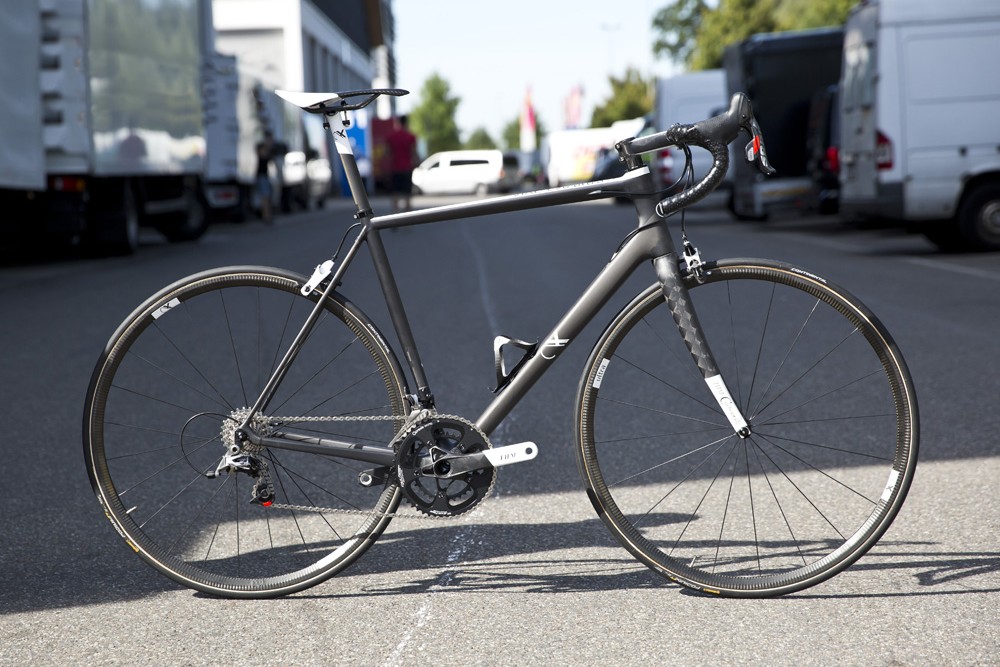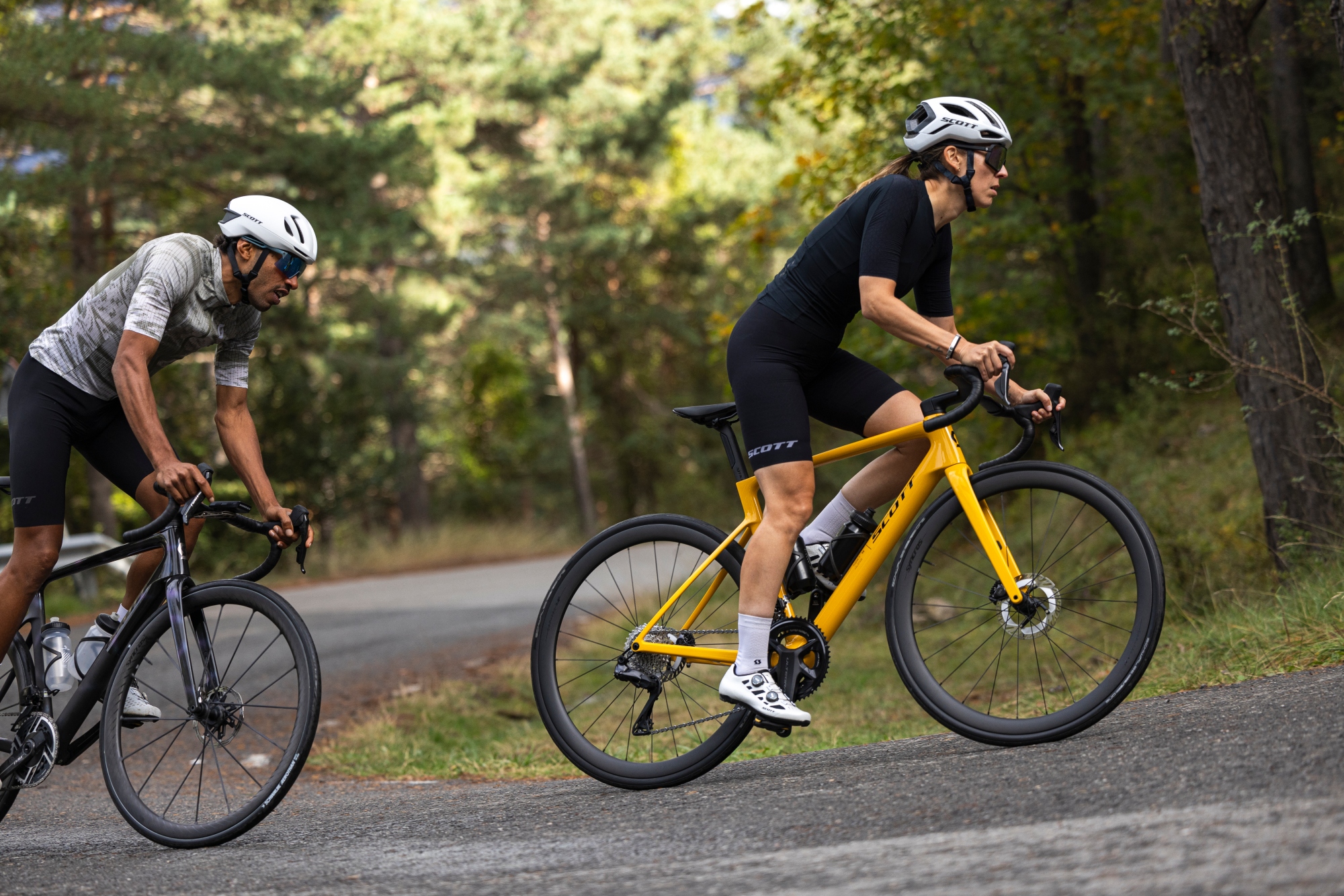
The new Scott Addict RC is here - or what there is of it, 5.9kg of bike to be precise.
Scott has officially updated its climbing bike for the first time since 2020, claiming the new Addict RC is the 'lightest ever road bike' the brand has produced.
The new bike features far more slender tube profiles, frame walls as thin as 0.6 millimetres, and a world class spec which all help keep weight to a minimum. The bike hopes to be genuinely user-friendly too, with 34mm tyre clearance, an integrated handlebar multitool, and enough of a focus on aerodynamics to be within a stones throw of the brand's aero Foil RC aero race bike.
The headlines
First things first, let's tackle the main headlines, and first answer the question - is this the lightest ever production road bike full stop?

A quick Google search brings up two familiar contenders. First up is the Specialized S-Works Aethos, boasting a claimed weight of 6.34 kilos. Then there’s the AX Lightness VIAL Evo Ultra, with an eye-popping weight of just 4.8 kilos.
The AX Lightness may win the numbers game, but it sacrifices practicality in the process. The Addict RC, on the other hand, balances feather-lightness with usability, featuring disc brakes, decent tire clearance, and a host of other features I’ll explore shortly.
As far as claimed weights go, we are looking at 600 grams for an unpainted medium frame, and 270 grams for an unpainted regular-length fork which makes for a 161 and 54-gram respective weight saving over the outgoing model. It's worth noting these weights are for the HMX-SL frameset, which is only available in the Addict RC Ultimate build. The HMX frameset found on the other four build options weighs around 40 grams more.
The new bike also claims to 12 watts faster than its predecessor, and just 9 watts slower than the Scott Foil RC aero bike at a test speed of 45kph and yaw angles of +/- 15 degrees, when testing the frames independent of their components.

Scott has also gone to great lengths to shave precious grams off of the whole frame kit (that includes hardware), with further savings being made in the seatpost, and Syncros one-piece carbon fibre cockpit.
The specification - how did they get the weight so low?
If you love watching engineers push boundaries just because they can, you’ll enjoy the obsessive attention to detail that Scott’s team poured into this project.
To hit such an impressively low weight, the Swiss brand has taken a methodical approach to weight loss. Every component was scrutinized, redesigned, and optimized to perform robustly and reliably while shedding every possible gram. The result? A claimed 300g drop in weight from the entire frame kit.

All those tiny savings add up. The Scott Addict RC Ultimate claims to shave 800 grams from the full build compared to its predecessor, arriving at a weight of 5.9 kilos. Scott wanted to trim weight everywhere without sacrificing functionality.
This meticulous approach even led to the development of a new manufacturing technique, dubbed Polypropylene Molding Core. The interior of the frame is as smooth as possible, eliminating excess carbon fiber and epoxy. This refined process is also said to eliminate wrinkles and voids in the carbon fibre structure, allowing Scott to use less material yet still guarantee safety and stiffness. In some places, the frame is an astonishing 0.6mm thick - a testament to just how far Scott was willing to push the limits.

While the Sram Red AXS groupset plays a major role - it’s the lightest on the market - the rest of the bike is brought to you almost always courtesy of Scott. There are one or two outliers though, one of them being the Schwalbe tyres. The yet-to-be-released Schwalbe Aerothan tyres were teased at Eurobike and even raced to victory in a Tour de France stage this year. These 28c tyres are unbelievably light - just 169g for a 28mm tyre. This makes the unreleased tyres the lightest on the market for the width, greatly helping the Addict RC’s overall numbers.

Then there are the wheels. The Addict gets Scott's subsidiary brand Syncros' Capital SL40 wheels weighing just 1170 grams for the pair. These 40mm-deep wheels, with their 25mm internal width, not only contribute to the bike’s featherweight build but also play a key role in its ride quality. Featuring reliable DT Swiss internals, they enhance performance and complement the bike’s ultralight design beautifully.
New Syncros bars complete with built in multitool
A word we will all be hearing a lot more of over the next twelve months is 'system weight'. As brands struggle to shave grams or watts from the frame alone, we are increasingly seeing finishing kit and wheels playing a stronger hand in ensuring every new bike is more aero, lighter, and comfier.
It comes as no surprise then that Scott has invested a lot of development into the new Syncros IC-R100-SL cockpit. The new one-piece handlebar and stem is around 40 grams lighter than its predecessor, thanks to a new stem clamping design, and an improved carbon fibre layup.
Scott has also created a 3D printed magnesium titanium alloy computer mount, which weighs a scant 12 grams - but this is an additional purchase.

The other headline feature about the new bar is the hidden multitool.
Take a peak inside the handlebar drop, and you'll find a T25 torx key which will service every bolts on the bike. This is thanks to a streamlining of bolt specifications - something we absolutely love about the new Canyon Aeroad which did this back in July of this year.
A new geometry, and a nod to comfort
Scott has also said that the geometry for the new Addict RC has undergone a 'comprehensive redesign' too. The Swiss brand claims that the new geometry has been optimised for stock 30mm tyres, and aims to provide better handling for its weight, remaining stable at higher speeds.
For my first thoughts on how the bike rides, check out our first ride review of the new Scott Addict RC.
Scott has also laid a big emphasis on comfort with the new Addict RC, which starts within the frameset. Thanks to a redesigned seat post clamping system, Scott has been able to design a seat tube with thinner walls, which ultimately increases flexibility in this area of the frame, allowing for more vertical compliance.
The new seatpost is 10% lighter, and claims to increase comfort by 30%. This comes alongside the clearance for 34mm tyres, which, if you were still worried about road buzz, should put your mind at rest.
Scott Addict RC build options
For those considering the Scott Addict RC but not necessarily aiming for the ultralight, range-topping Ultimate model, there are four other builds to explore.
At the bottom of the range, you have the Addict RC 30. At $4,999 / £4,899 / €4,999, it kicks of the range with Shimano 105 Di2, Syncros Capital 1.0 40mm wheelset, and a two-piece handlebar and stem.
Next up is the Addict RC 20, which retails for $5,699 / £5,899 / €5,999. The RC 20 upgrades to Shimano Ultegra Di2, with the same cockpit and wheel setups.
The RC 10 drops more weight and includes a one-piece carbon fibre cockpit retailing at $6,599 / £6,599 / €6,699.
Next, we have the Addict RC Pro, which comes with Shimano's Dura-Ace Di2, and costs $8,999 / £8,599 / €8,699
And of course, the Addict RC Ultimate complete with Syncros Captial SL40 wheels and Sram Red AXS groupset, will set you back $14,999 / £12,799 / €12,999.
Now, of course, this is incredibly expensive for a two-wheeled man-powered machine, so to put all this into perspective, I thought I would run through some comparisons to similar bikes for each model.

At the more accessible end of the spectrum, the Addict 30 stands out. For the price, weight, and overall specification, it’s hard to beat. When compared to the Specialized Aethos, you can either save money by going for the Aethos Comp build (and sacrifice carbon wheels and opt for a third-tier carbon layup) or spend an extra £850 for the Aethos Expert build and save a mere 200 grams. To put that in perspective, saving 200 grams elsewhere could cost the same - or less.
The Addict 20 tells a similar story. In its price range, it competes effectively. While you could spring for the Aethos Expert build again, this option doesn’t quite match up when you consider its third-tier groupset.
One model in the Addict lineup that’s harder to justify, in my opinion, is the Addict 10. Here, you’re paying an additional £700 for the integrated cockpit, and frankly, I would have liked to see a power meter included at this price point to give it more value and distinction.

On the other hand, the RC Pro - the Dura-Ace build - holds its own. While the Aethos Pro comes in £600 cheaper, the Addict steps up with a higher-tier groupset, the slick integrated cockpit and a weight saving of around 280 grams. However, the Aethos does gain a slight edge with the inclusion of a power meter, and again, it’s disappointing that Scott didn’t add one here.
Simply put, the new Addict RC range is competitive in every category of weight, price, and specification. Even if the model you choose isn’t sub-six kilos, it will likely be the lightest - or among the lightest - options within its class.
For more information, check out the Scott Website.







